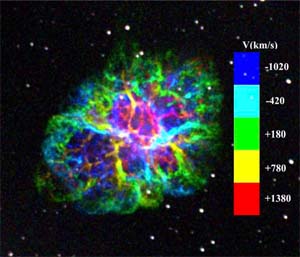 A team of researchers from Laval University, all members of the CRAQ, produced the first 3D-map of the Crab nebula with the instrument SpIOMM at the Observatoire du Mont-Mégantic. This one-of-a-kind imaging spectrometer instrument was developed by graduate students under the supervision of Professor Laurent Drissen at the Department of Physics, Physical Engineering and Optics of Université Laval. It allows the simultaneous measurement of the velocity of gas filaments in a nebula which is then used to reconstruct a tridimensional representation. A team of researchers from Laval University, all members of the CRAQ, produced the first 3D-map of the Crab nebula with the instrument SpIOMM at the Observatoire du Mont-Mégantic. This one-of-a-kind imaging spectrometer instrument was developed by graduate students under the supervision of Professor Laurent Drissen at the Department of Physics, Physical Engineering and Optics of Université Laval. It allows the simultaneous measurement of the velocity of gas filaments in a nebula which is then used to reconstruct a tridimensional representation.
The instrument SpIOMM, for Spectromètre Imageur de L'Observatoire du Mont-Mégantic (Imaging Spectrometer at the Observatoire du Mont-Mégantic), is a Fourier transform imaging spectrometer developed by Frédéric Grandmont during his PhD at the Université Laval. In other words, it is an astronomical instrument capable of obtaining observational data cubes at multiple wavelengths. Therefore, for each pixel of the image, astronomers gather a wealth of information over a broad range of wavelengths (spectra). The data, which include the hydrogen, nitrogen and sulphur spectral lines, allows astronomers to determine the chemical composition at each point of the nebula. Moreover, it allows a measurement of the density of the filaments and the velocities at which they are moving, toward or away from us.
During the supernova explosion about a thousand years ago, the gas was ejected from the star's surface at velocities as large as 10000 km/sec. Even if this material gradually slowed down over time, it still remains quite large. Indeed, the data obtained by SpIOMM show evidence that the gases still have velocities on the order of 1500 km/sec. The 3D-map of the Crab nebula obtained with SpIOMM reveals the asymmetrical morphology of the filaments, the electron density in the gas, and the relative nitrogen abundance. In addition, the 3D animation of the nebula (http://www.youtube.com/watch?v=HqK7kyIug-0) indicates clearly that the explosion itself was neither symmetrical nor homogeneous since we observe a filamentary morphology superimposed with clumps of various densities. The study of the Crab nebula was presented in the Master thesis of Maxime Charlebois. The team at Université Laval is now applying the same technique of imaging spectroscopy (also called hyperspectral imaging) to other objects in the Milky Way, such as Cassiopeia A, a supernova remnant younger than M1. The objective is to better understand the explosion of massive star and more specifically, the mechanisms involved in the mixing of the heavy elements ejected by the star with the interstellar medium.
The team of Prof. Drissen, holder of a Research Chair in Astrophysics, in a collaboration with the company ABB of Québec, proposed an improved version of SpIOMM, called SITELLE, for the Canada-France-Hawaii Telescope. The key science driver of this instrument is to measure of the star formation rate in the Universe during the last 5 to 7 billion years.
Media contact:
Olivier Hernandez, Ph.D.,
CRAQ – Université de Montréal
Tel: 514-343-6111 ext 4681
olivier@astro.umontreal.ca
|

 A team of researchers from Laval University, all members of the CRAQ, produced the first 3D-map of the Crab nebula with the instrument SpIOMM at the Observatoire du Mont-Mégantic. This one-of-a-kind imaging spectrometer instrument was developed by graduate students under the supervision of Professor Laurent Drissen at the Department of Physics, Physical Engineering and Optics of Université Laval. It allows the simultaneous measurement of the velocity of gas filaments in a nebula which is then used to reconstruct a tridimensional representation.
A team of researchers from Laval University, all members of the CRAQ, produced the first 3D-map of the Crab nebula with the instrument SpIOMM at the Observatoire du Mont-Mégantic. This one-of-a-kind imaging spectrometer instrument was developed by graduate students under the supervision of Professor Laurent Drissen at the Department of Physics, Physical Engineering and Optics of Université Laval. It allows the simultaneous measurement of the velocity of gas filaments in a nebula which is then used to reconstruct a tridimensional representation.